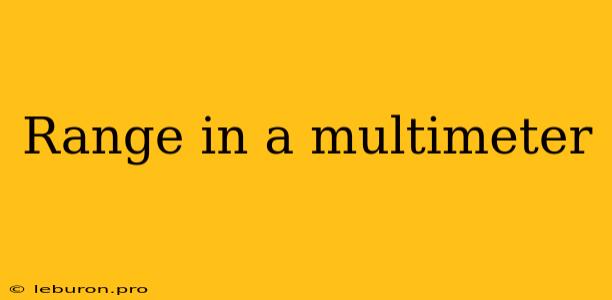Multimeters are indispensable tools for anyone involved in electronics, whether it's a seasoned professional or a hobbyist. These versatile devices measure various electrical parameters, including voltage, current, resistance, and more. One of the crucial aspects of using a multimeter effectively is understanding and selecting the appropriate range. The range setting determines the maximum value the multimeter can measure for a given parameter. This article will delve into the concept of range in multimeters, explaining its significance, types of ranges, and how to choose the right range for accurate measurements.
Understanding Range in a Multimeters
The range of a multimeter refers to the upper limit of the measurement it can handle for a specific parameter. Each parameter, such as voltage, current, or resistance, has its own set of ranges. For instance, a multimeter might have voltage ranges of 200mV, 2V, 20V, 200V, and 1000V. This means that the multimeter can accurately measure voltages up to 200mV in the lowest range, up to 2V in the next range, and so on.
Why is Range Important?
Selecting the correct range is crucial for obtaining accurate and reliable measurements. Here's why:
- Overload Protection: Multimeters are designed with internal protection mechanisms to prevent damage from excessive current or voltage. If you attempt to measure a value exceeding the selected range, the multimeter might be damaged.
- Accuracy: Using a range that is too high for the measured value can lead to inaccurate readings. The measurement will be displayed on a smaller portion of the multimeter's display, leading to less precise results.
- Resolution: Choosing the appropriate range ensures that the multimeter displays the measurement with sufficient resolution. A lower range provides finer increments on the display, enabling you to read smaller changes in the measured value.
Types of Ranges in Multimeters
Multimeters typically offer a variety of ranges for each parameter. Here's a breakdown of the common types:
Voltage Ranges
- DC Voltage: Multimeters have ranges for measuring direct current (DC) voltages, often found in batteries and electronic circuits. Common ranges include 200mV, 2V, 20V, 200V, and 1000V.
- AC Voltage: For alternating current (AC) voltages, such as those found in household outlets, multimeters have dedicated ranges. Typical ranges include 200V, 750V, and 1000V.
Current Ranges
- DC Current: Ranges for measuring direct current are usually denoted by milliamperes (mA) or amperes (A). Common ranges include 200mA, 2A, and 10A.
- AC Current: Multimeters can also measure alternating current. Ranges for AC current are similar to DC current, with typical values like 200mA, 2A, and 10A.
Resistance Ranges
- Resistance: Multimeters have ranges for measuring resistance in ohms (Ω). Common ranges include 200Ω, 2kΩ, 20kΩ, 200kΩ, and 2MΩ.
Choosing the Right Range
Selecting the appropriate range is a critical step in using a multimeter. Here are some tips to help you choose the right range:
- Estimate the Expected Value: Before taking a measurement, try to estimate the approximate value you expect. This will help you select a range that is appropriate for the anticipated reading.
- Start with a High Range: It's generally a good practice to begin with a higher range and then gradually reduce it until the measured value falls within the display's range. This minimizes the risk of overloading the multimeter.
- Observe the Display: The multimeter's display will usually indicate if the selected range is too low for the measured value. You might see an overload symbol, a flashing display, or an inaccurate reading.
- Consult the User Manual: Your multimeter's user manual will provide detailed information about the available ranges and how to select them.
Conclusion
Understanding and utilizing ranges effectively is crucial for accurate and safe multimeter operation. By choosing the appropriate range for each measurement, you ensure that the multimeter provides reliable data and avoids potential damage. Remember to always estimate the expected value, start with a higher range, and observe the display carefully. With practice and a solid understanding of ranges, you can master the use of a multimeter and confidently perform various electrical measurements.
